

Search london history from Roman times to modern day
A historical site about early London coffee houses and taverns and will also link to my current pub history site and also the London street directory
OLD HOUSE IN CLERKENWELL - Illustrated London News, August 17, 1844
The building of New Farringdon-street, engraved in No. 95 of our Miscellany, is
gradually progressing; and, in clearing the ground for its continuation
northward, some dwellings of considerable antiquity have been exciting much more
of the public attention than they are entitled to.
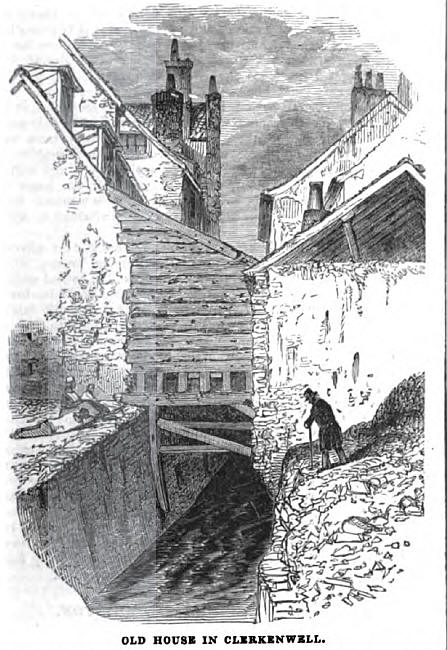
The former Red Lion Tavern, West street - on the west bank of Fleet River
Among them is the house represented in our first engraving: it is situate in West-street, formerly called Chick-lane, at which point New Farringdon-street now terminates; it is reputed to have been built 300 years ago, and was once known as the Red Lion Tavern; but, for the last century, it has been used as a lodging-house. It is situated on the west bank of Fleet River, now called the Fleet Ditch, and used as a common sewer. As our engraving shows, it has a lofty gable; but the tiled roof and whitewashed exterior walls, do not denote the actual age of the structure. Our engraving represents the exterior of the house, the artist looking southward, up Fleet Ditch, towards the Thames.
The mode in which this house is internally disposed denotes, it to have long been “a den of thieves;” and up to the last Middlesex sessions it was tenanted by persons of dishonest and abandoned habits. It has all the conveniences of a hiding-place, with concealed means of escape—in dark closets, sliding panels, and secret recesses, and by as many trap doors as in the stage of a theatre... By passing down one of these traps, the pursued could elude the vigilance of the police, by getting through a window and crossing the Fleet Ditch over a plank which was kept at hand, and afterwards drawn into the opposite house. The pursued might then pass into Black Boy-alley, and thereby get into Cow-cross, and the knot of courts and alleys in that neighbourhood. Immediately under the basement is a capacious dark cellar, and contains a den, or cell, wherein have been found a human skull and some bones, and the top of a butcher's steel, bearing on it “Benjamin Turtell, July 19, 1787,” in silver letters and figures. This cell is about four feet wide, and nine in depth, excavated in the rough earth. It was here that a chimney-sweep, named Jones, who escaped out of Newgate about three years since, was so securely hidden, that, although the house was repeatedly searched by the police, he was never discovered, till it was divulged by one of its inmates, who, incautiously observing that he knew whereabout Jones was concealed, was taken up, and remanded from time to time as an accessory to his escape; but when at last tired of prison fare and prison discipline, pointed out the place to obtain his own liberty; Jones had his food conveyed to him through a small aperture, by a brick or two being left out next the rafters.
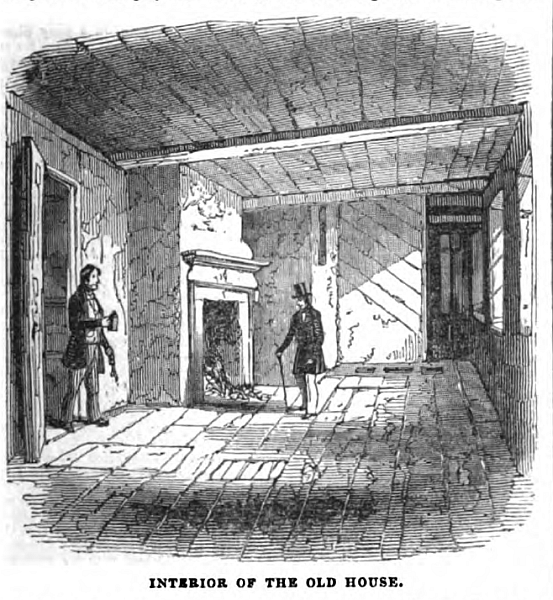
Inside the former Red Lion Tavern, West street
It was here, about seven years since, that a sailor was robbed, and afterwards flung naked, through one of the convenient apertures in the wall, into the sewer, for which two men and a woman were transported for fourteen years. The second engraving shows the room, on the ground floor, long occupied as a chandler's shop, by way of lulling suspicion. Immediately behind the counter were trap-doors, one of which was used as a means of escape, and the other opened into a secret depository for stolen articles. Upon the first floor, too, are several hiding-places; and among the contrivances is a spout, the entire extent of the house, through which stolen property could be removed with the greatest dispatch. The means of escape through the roofs, and their communication with the roofs of the adjoining houses, are also very intricate. It is related that, on one occasion, though the premises were surrounded by seven police officers, a thief made his escape by its communications with the adjoining houses, which were all let out to the lowest characters. This house (No. 3) is stated to have been the abode of the notorious Jonathan Wild, but we are not aware of the authority for the statement. There has, however, been found in one of the rooms, an old, rusty, nearly worn-out knife, the blade, of which bore the name of “Rippam," and on the handle “J. Wilde.” It is of very peculiar make, and evidently of ancient manufacture. These premises, we should add, are approached by West-street, through the gateway of the Red Lion ; the adjoining house is old, but has not the fittings of its neighbour.
This extraordinary place has been inspected by his Royal Highness the Duke of Cambridge, Lord, Lonsdale, parties of magistrates, and a crowd of visitors, for some days past. By the active measures of the commissioners for carrying out the improvements in this neighbourhood, possession was obtained of the property, on compensating the freeholders, and the houses have since been taken down. It is impossible, to look upon the place, seated, upon the bank of a foul ditch, without reflecting upon the two-fold pestiferous influence of this moral and physical nuisance in the very heart of our metropolis; and it is only in this view, and as a fragment of old London, that the place is entitled to illustration in our columns. The eagerness, however, with which crowds have flocked to this den of infamy, proves that the morbid taste for Jack Sheppardism is not yet extinct. West-street, by the way, debouches into Field lane, that notorious region of Bandana, admirably described by Mr. Dickens, in his master-piece, “Oliver Twist.”
The Fleet, of which we get a glimpse in the first engraving, was formerly navigable to a considerable extent. Along this rapid stream, whence its name, the Danish fleet, under King Sweyn, passed, after burning Southwark, and anchored in triumph beside the spot, now known as Bagnigge-wells. Stow tells us, that the river was “of depth and width sufficient, than ten or twelve ships at once, with merchandise, were wont to come to the bridge of Fleete.”. According to another writer, “the tide flowed as high as Holborn bridge, where there were five feet of water at the lowest tide, and brought up barges of considerable burthen.” Yet, this falls considerably short of vessels sailing up to Bagnigge-wells!
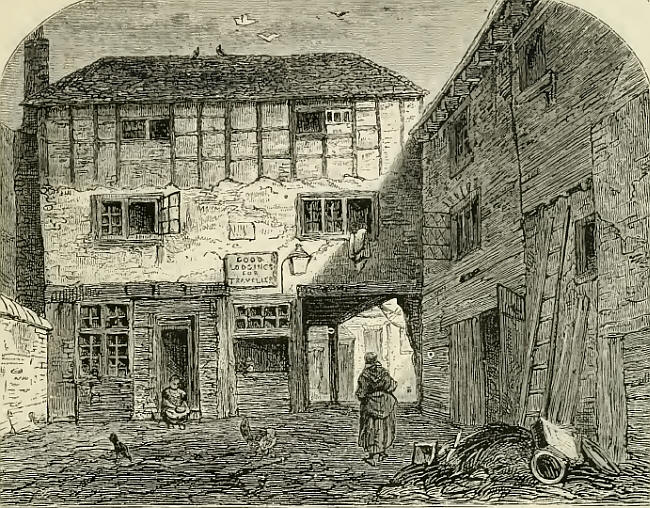
Former Red Lion Tavern, West street - shortly before its demolition - front view
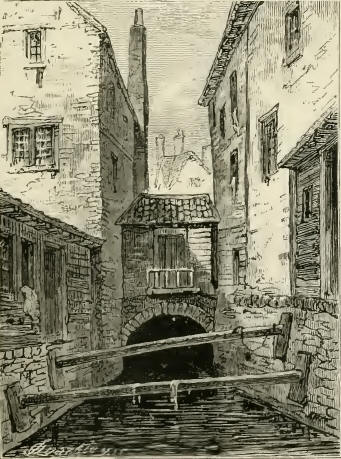
Back of the former Red Lion Tavern, West street - shortly before its demolition - from the Fleet
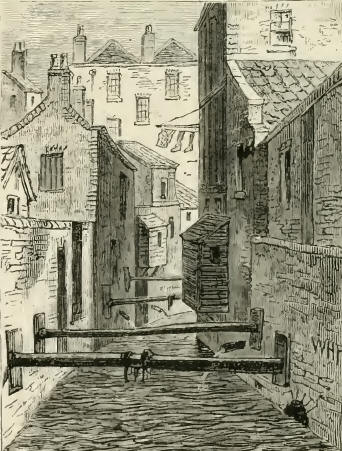
The Fleet ditch from the former Red Lion Tavern, West street - shortly before its demolition
Among other infamous lurking-places of thieves pulled down
for the Clerkenwell improvements of 1857, was the notorious West Street,
formerly known by the innocent name of Chick Lane. Stow mentions it, in 1633, as
near a timber bridge that crossed Turnmill Brook (near the end of Field Lane).
In a flood in 1661, when casks swam down the streets, several hogs were washed
out of their sties in Castle Inn Yard, Smithfield, and were carried down to
Chick Lane.
There was a cruel murder committed in Chick Lane in 1758. Two women named
Metyard killed a woman named Naylor, and then cut up the body, intending to
throw the pieces down the gulley-hole in Chick Lane, but eventually left them in
the mud which had collected before the grate of the sewer. The two women were
convicted of the murder ten years after, and were both hung at Tyburn in 1768.
At an inquest, in 1834, at the "Horseshoe and Magpie," Saffron Hill, on a man
found dead in a low lodging-house in West Street, the landlady deposed that in
her house there were eight beds in one room, and two or three persons in each
bed.
Near Chick Lane was Cow Bridge, mentioned by Stow as north of Oldbourn Bridge,
over the River of Wells. In the time of Elizabeth the ground from Cow Cross
towards the river Fleet, and towards Ely House, was either entirely vacant, or
occupied with gardens.
"Among the houses in West Street," says Mr. Pinks, "was one which was, at the
time when it was demolished, supposed to have been built about three hundred
years. It was once known as the 'Red Lion Tavern,' but for the century preceding
its destruction it was used as a lodging-house, and was the resort of thieves,
and the lowest grade of the frail sisterhood. It was numbered 3 in West Street,
and was situate on the north-west side of the Fleet Ditch, a few houses from
Saffron Hill, and at the eastern corner of Brewhouse Yard. It was sometimes
called Jonathan Wild's House, and 'the Old House in West street.' From its
remarkable adaptation as a hiding-place, with its various means of escape, it
was a curious habitation. Its dark closets, trapdoors, sliding panels, and
secret recesses rendered it one of the most secure places for robbery and
murder. It was here that a chimney- sweep named Jones, who escaped out of
Newgate about three years before the destruction of the house, was so securely
hidden for about six weeks, that, although it was repeatedly searched by the
police, he was never discovered until his lair was divulged by one of its
inmates, who, by incautiously observing that he knew whereabouts Jones was
concealed, was taken up and remanded from time to time as an accessory to his
escape, but who, at last, tired of prison fare and prison discipline, pointed
out the place to obtain his own liberty. Jones was concealed by parting off a
portion of a cellar with brickwork, well besmeared with soot and dirt, to
prevent detection. This cell, or, more properly, den, was about four feet wide,
by nine in depth; and during Jones's incarceration therein, he had food conveyed
to him through a small aperture, by a brick or two being left out next the
rafters. It was here that a sailor was robbed, and afterwards flung naked
through one of the convenient apertures in the wall into the Fleet, for which
crime two men and a woman were transported. A skull, and numerous human bones,
were found in the cellars. Numerous parties daily visited the premises, among
whom were many of the police and county magistrates. It was said to have been
the rendezvous, and often the hiding-place, of Jack Sheppard and Jerry Abershaw;
and the place looked as if many a foul deed had been there planned and decided
on, the sewer or ditch receiving and floating away anything thrown into it. On
one occasion the police had surrounded the house to take a thief, whom they knew
to be there, but he made his escape in their actual presence. At another time an
officer went into one of the rooms to apprehend a man, and saw him in bed. While
at the door, calling to another to help him, he turned his head and saw the man
getting under the bed. He did not take any notice of it, but when the other man
came up, on looking under the bed, the man had vanished. After some search they
discovered a trap-door through which one of them jumped, but he, breaking his
leg in the fall, the fellow escaped. In this house was a place where a gang of
coiners carried on their trade, and had also a private still. This place, like
all the rest, had a communication with the sewer. In one of the garrets was a
secret door, which led to the roof of the next house from which any offender
could be in Saffron Hill in a few minutes. Amongst Mr. Crosby's drawings are a
view of this old house, taken August 10, 1844; and an inner view of the cellar
windows, taken August 19, 1844. The pulling down of this house was commenced on
the first-mentioned date. It appears to have been left standing several years
after some of the surrounding buildings had been removed." Three views of the
old house taken shortly before its demolition are shown above.
References :
Lots of references are made to two sources on the
internet archive
:
Walter Thornbury, Old and new London 1875 &
Illustrated London News August 1844 - google books
Trying to avoid privacy and cookie settings overwriting content